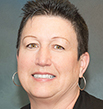By BETSY TAYLOR
Theresa Conejo, a nurse and heart failure coordinator at Nazareth Hospital in Philadelphia, has received multiple awards for her outreach work to minority patient populations. She was most recently honored by the American Heart Association as Health Care Volunteer of the Year in part for her advocacy for public policy to eliminate health care disparities. She is a member of that organization's Stroke Council Minority Affairs Committee.

Theresa Conejo
She spoke with Catholic Health World about ways that health care systems and providers can re-duce barriers to care for diverse populations of patients. Conejo became interested in care improvements across cultures when a 30-year-old pregnant Mexican woman she was teaching in an English as a Second Language class died of hemorrhagic stroke despite seeking care. Conejo said the doctor didn't speak Spanish, and the woman couldn't get her point across about the severity of her symptoms. Conejo advises organizations locally, statewide and nationally on health care outreach to minority populations.
Do you find that approaches to reach one minority community work for other minority communities?
There are some commonalities. First of all, the community health needs assessment helps us identify the physical barriers and knowledge barriers that individuals or families have in accessing education, social services, health services. It shows the needs of a particular community. From there, I think you need to connect with certain community organizations and leaders.
I have found with Latinos, for instance, you can reach them through the Catholic Church, where there's trust and trusted leaders. We've had great success through the church. I think you need to identify and utilize influencers in a community, people who families turn to for advice and counsel. At Nazareth Hospital, we have a patient-family advisory group, where we ask a patient or family member to give us ideas of things we can do here to make the hospital stay at Nazareth better. We encourage diversity and have some Latinos and Portuguese people in the group currently.
You also have to meet people where they are. For example, the American Heart Association wanted to do an initiative for Mexican residents of South Philadelphia with a mobile kitchen to teach healthy cooking and eating. They proposed having the planning meeting at the American Heart Association office in center city. I said, "No, you need to go to their community. Let's make the meeting in a restaurant in the area we're trying to reach people." You need to meet them, and see where they live and be part of their environment. So we did. You need to go to them. It's important to meet people where they are and show them that you are sincere.
What do a lot of health care providers not know about caring for diverse populations that they need to know?
Many health care workers, not all, lack in cultural competency. They lack knowledge about different cultures. If their hospital draws a lot of patients from a particular culture or cultures, they need to be mindful of that. We're making progress at Nazareth Hospital by taking steps to educate our staff about other cultures and extend a hand to the community.
If a health care provider wants to understand a particular culture, and the hospital isn't offering cultural competency training, where can an individual go for resources?
I would say find someone within your organization you can talk to. We're lucky here at Nazareth Hospital, we have employees of many different cultures. I would just tap into some of my colleagues and ask them. I have no problem asking, for example, "In your culture, what are the beliefs related to end of life?"
How can health care providers gain insight into whether an individual's circumstances and cultural norms might impact that person's health status and compliance with a doctor's recommendations?
A good nursing assessment addresses social and cultural aspects of care. First of all, language barriers need to be resolved with a translator, or with a language translation phone, which can be used for translation services. An assessment considers the patient's educational background, and providers can modify how they communicate as a result. Do I need to present this information on a sixth grade level, or am I speaking with someone who is of a higher literacy level? Questions need to be asked about where a patient lives, who lives with them, what their home life and neighborhood are like. Do they have health insurance? Access to transportation? Do they rely on family members to drive them? Do they have money to pay for the medicine we're prescribing? We can connect them to resources once we identify what's needed.
What additional factors should health care systems consider in improving care access for patients from minority groups?
Well, as an example, many immigrants work six days a week, so they rely on evening office hours and weekend office hours. Sunday may be the only free day they have.
There's a fear among undocumented people about deportation, which prevents them from seeking medical help sometimes. I see they're a little uneasy and quiet sometimes when they first come in, especially if it's someone pretty new to the country. It's important to communicate to the patient that the hospital's objective is to get them well, without regard to their immigration status.
Another important factor is hiring employees from across different populations and involving a diversity of people on councils, programs and committees within the hospital.
Copyright © 2017 by the Catholic Health Association
of the United States
For reprint permission, contact Betty Crosby or call (314) 253-3490.